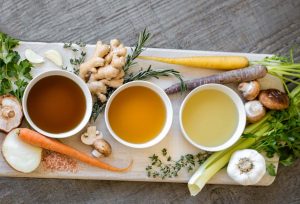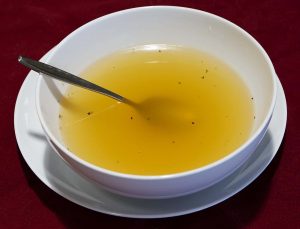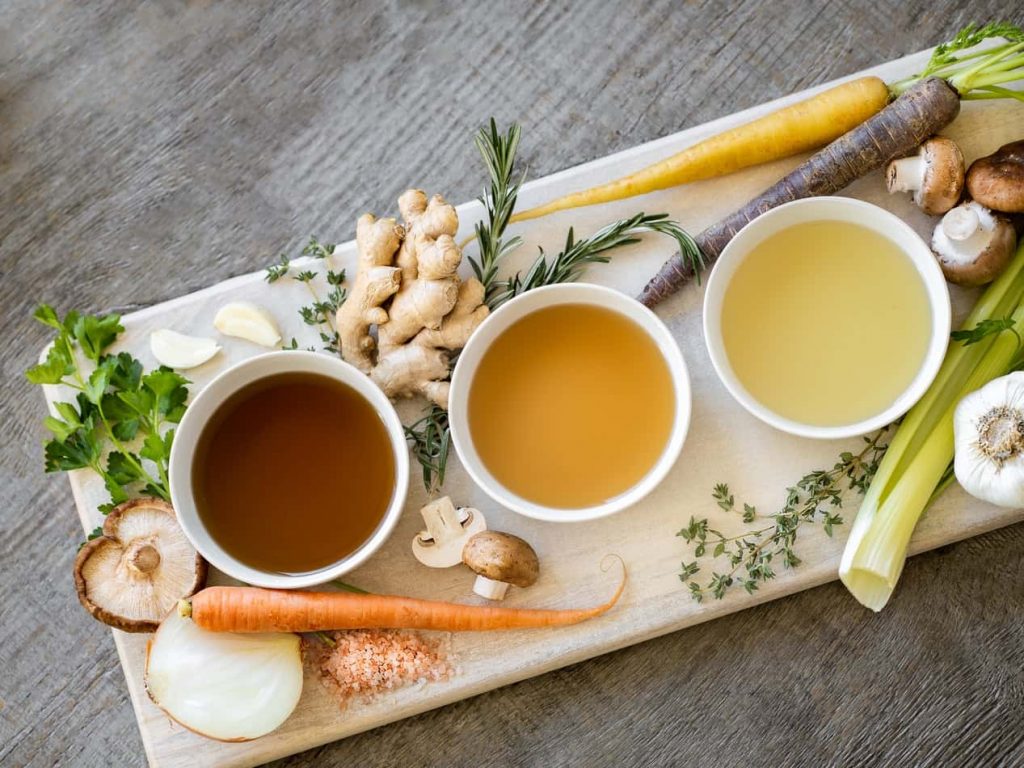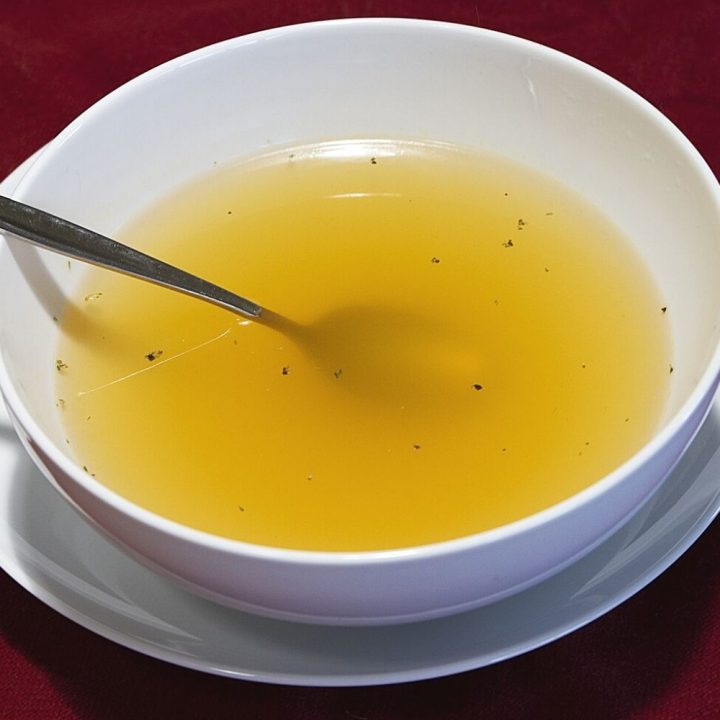Chef Julia Child once said, ‘You don’t have to cook fancy or complicated masterpieces. Just cook good food from fresh ingredients.’

Today we uncover how to encompass the freshness of your vegetables while making your life and cooking more straightforward and quicker with the use of stock and broth.
Contents
Are Broth & Stock the Same?
We have all at some point thought stock and a broth were the same things, right?
What appears as interchangeable terms are two different savory liquids.
Both stock and broth are used in soups, curries, and gravies, yet they have different consistencies and variations in ingredients.
The ingredients, cook time, and use of seasoning create the differences between stock and broth.
The easy signifier of the difference between stock and broth is to consider the result.
Stock is made with bones and is rarely served on its own, whereas broth is made from fat and meat and can be eaten independently or with thick crusty bread or heavy suet or flour dumplings or cobbler.
Broth tends to be oilier than stock due to the meat juice and fat content and is the less healthy option out of the two, and is used to create a thicker sauce, paste, or gravy.
The simplest way to remember the difference between stock and broth is the broth is made from meat or vegetables and is thinner and contains no bones, whereas stock is made of bones.
Can I substitute broth for stock?
The good news is that you can substitute stock for broth, so long as your recipe isn’t a vegetarian recipe and you then use meat stock!
As broth has meatier parts added to make it and therefore contains more meat-based collagen, which creates its richer texture, you can use either stock or broth.
You can interchange between chicken and beef stocks and broths too, which will result in varying flavors but won’t make or break the recipe.
However, be mindful of your stocks and broth’s salt content, especially when using store-bought ingredients that most likely have additional salt added, requiring you not to add extra salt during your cooking.

What’s healthier, stock or broth?
When looking at the nutritious fax and benefit of both stock and broth, they are both nutritionally similar.
A broth is a lower calorie option; however, stock contains more vitamins, collagen, marrow, and multiple minerals despite its long cooking process. Collagen is widely seen as a significant health benefit.
It is present in stock due to the usage of bones and other proteins, which provide additional benefits for your immune system.
You can also add herbs and spices to boost not only the flavor profile of your stock or broth but also the health benefits of it too.
Variations of stock provide different health benefits. Bare bone stock has been discovered as the most beneficial to your health, with chicken coming in second due to its lean qualities and keto benefits.
The vegetable stock has the ability to pack in more vitamins into both stock and broth than its protein-rich versions.
This is due to the multiple variants of vitamins of each vegetable used within a stock or broth.
What has more flavor stock or broth?
The stock and broth flavor options are endless. Whether you’re looking for an earthy taste, roasted, flavor or a spicy hint to your dish, your use of herbs and spices will not only aid the marinate thing of your protein will also provide your food its aroma.
The use of salt is fundamental to both the stock and broth and is an often debated topic for premade stock cubes and granules.
Salt is an essential part of stock and broth and is necessary for developing the flavors of your protein and your vegetable stops.
The world health organization recommends no more than 5 g of salt per day, just under one teaspoon.
Your use of salt will determine both the flavor of your food and its health benefits. Sea salt, Himalayan salt, and flavored salts are pure forms of salt that work well in crockpots, rubbed into meats, and within a meat-based broth or stock.
Widely used find table salt will still work but will provide a very mild activation of flavor within your food.
Laura Rowe recommends in her book taste; they should combine diced onion, carrots, and celery in a mirepoix to form the base of stocks, stews, sauces, and soups, and unstoppable trio.
Garlic is a fundamental feature of both stock and broth, and with hundreds of types of garlic to choose from, the regular store-bought or farmers market purchased will work well whole or chopped into a stock or broth.
Great garlic pairings for stock and broth:
- garlic, chili, ginger
- garlic, basil, tomato
- garlic, onion, celery
- garlic, rosemary, lamb
Great herbs. And broth recipes:
- Tarragon
- Parsley
- Basil
- Mint
- Oregano
- Time
- Sage
- Bay
- Rosemary
As Bay is one of the toughest herbs going, bay leaves are covered essential that provide natural aroma when dried and fresh.
With a subtle spiciness to its flavor profile, be sure to remove bay leaves before serving.
The robustness from Rosemary adds a fragrant element to dishes, infuses stocks and sauces, and marinades chicken and paneer well, once again providing protein options for non-meat eaters.

Seasonal Stock
Seasonal vegetables are ideal for making stock freeze, especially for those light, spring-time flavors, or post-thanksgiving turkey oil and fat.
Encapsulating the seasonal savory flavor for later on in the year is the gift that keeps on giving.
When the product is out of season, and you can’t get the taste you’re craving, you’ll be glad you planned.
Be sure to add the essential go-to vegetables such as onions, garlic, carrots, and additional flavorings such as salt, pepper, and garlic as your base stock, allowing the focus to remain on your seasonal stock star.
Does Bouillon make broth or stock?
Bouillon is a stock that is most often, however, not always meet based their range includes bone stock, meat stock, vegetable stock, and a vegan stock containing no animal products.
Bouillon is designed to be impactful with its flavors providing fragrant herb kicks to meat dishes such as pies, curries, and soups.
Most of us have Bouillon in the back of our kitchen cupboards. Bouillon is available in a variety of forms, including granules and dry cubes.
Should I use stock or broth for gravy?
You can use both stock and broth to create a gravy.
Using a stock within a meal containing meat will benefit its flavor profile of meatiness and provide the nutritional benefits stock has to offer as a result of the collagen created through bone boiling for the stock.
The vegetarian gravy makes no difference whether you use stock or a broth, as neither vegetarian stock nor vegetarian broth would contain meat bones.
Can I use chicken stock instead of broth for stuffing?
If you’re thinking of creating a roast dinner or perhaps a Thanksgiving dinner, you may wonder if you can use stock instead of broth for stuffing.
You can use stock or broth in the same way you can use either for gravy but always opt for a broth or a stock over plain water as water lacks the depth of flavor and adds no nutritional benefit to your stuffing dish.

Is bone broth the same as chicken broth?
Bone broth is the same as stock. For bone broth, the main focus protein is the bones themselves.
Bone broth is all about extracting the benefits and flavor profiles of the bones and into the broth.
The name of the dish creates confusion because, of course, the stock features bone boiling. But the focus on bone broth is to extract collagen, which is a health benefit.
As the name suggests, it is not vegetarian and features gelatin which is derived from pigs.
This combination is said to benefit your skin, nails, and hair, as well as promote healthy gut and digestion.
Bone broth is made from bones, not meat, so when making homemade bone broth, be sure to roast the bones first before boiling to extract the best tasting meat flavors.
What is the best chicken stock?
While the best chicken stock you can have will always be the one that you make yourself, sometimes we don’t have the time to create our own chicken stock from scratch.
There is a whole range of good quality, flavorful chicken stocks available in supermarkets, health food stores, and online.
Here are some of our favorites:
- Rachel Ray Stock in a box
- Porter Road Chicken Stock
- College Inn Fat-Free Lower Sodium Chicken Broth
- Trader Joe’s Organic Low-Sodium Chicken Broth
- Zoup Low-sodium chicken stock.
- Market Fresh Chicken Stock (UK)
Can You Drink Chicken Stock Cubes?
It’s not advisable to drink chicken stock cubes. Any stock cube in a powder or granule form is designed to be dilutive within a high volume of water and contains high levels of salt to assist with the flavoring and marinating process that occurs while cooking meats or vegetables.
Stock cubes do make an excellent base for soups but only when used with other proteins and vegetables and carbohydrates such as noodles and potatoes.
Always be mindful of your sodium levels, especially if you have any dietary requirements or existing health issues.
It is well documented that stock cubes feature high levels of sodium and are not a nutritious match to fresh stock using fresh ingredients that are unprocessed.
Diabetes UK recommends making your stock as opposed to using a shop-bought stock.
While it wouldn’t harm you to drink chicken stock on occasion, it would not be beneficial to your health long-term and ideally should only be used when cooking a meal.
While the stock isn’t created as a meal within itself, the exception to stock being used as a soup is Asian soups. Noodle soup and stock-based miso soups are thinner in consistency and come with their comfort factor.
Simple to prepare, using minimal ingredients and often thrown together in under 10 minutes, you combined stock with a packet of noodles or rice noodles and cook on the hob for a few minutes until the noodles are soft, wilting, and ready to be eaten.
The combination of stock with noodles will have infused them with the full flavor of your stock while remaining light and comforting.
This creamy soup is often what we think of when we feel under the weather, ill, or in need of comfort food.
The go-to ‘Chicken soup’ the promise of rest, bite, and rehabilitation.
How To Use Stock – Tips
- While you can easily buy stock powder or stock cubes in any supermarket, nothing beats the taste of the homemade stock. Homemade stock can be used for sources, gravies, stews, soups as well as other recipes and will without a doubt impact the flavor of your dishes; nothing beats fresh.
- While admittedly, making stock from scratch takes time from the gathering of ingredients and by-products such as skins and bones, the slow boiling up of bones, skins, or peels will gradually build up the flavor when combined with a core mixture of onions, carrots, and celery which create new aromas, the comforting smell of warmth and the coming together of great ingredients. The recommended simmer time for a stock is 4-6 hours.
- If you use a pressure cooker or boil your veg to prepare your meals, be sure to save the water when planning to make stock. Keep your vegetable water in the fridge until you are ready to make stock. Vegetable water can be kept in the refrigerator for up to 5 days. By using water that has already cooked vegetables, you are further enhancing the flavor of your stock when you use the water to cover and boil your meat bones and vegetables.
- If you’re a meat-eater, you can also mix in the juices of chicken, turkey, or pork for additional flavor, maximizing what you can get out of your food.
Can Vegetarians Use Chicken Broth?
Vegetarians cannot use chicken broth, and neither can vegans. Any dish, sauce, or ingredient containing animal traces such as meat, bone, or choice is not included within a vegetarian or vegan diet.
Those on a flexitarian diet may consider including chicken broth within their meals; however, this is always down to the individual.
Vegetarians and vegans typically use vegetable-based broth’s within their cooking and soups; this ensures that none of their meals are contaminated with meat-based products or juices.
Vegetable broth is the most versatile of broth types as it can be utilized with any protein and across most diet plans.
What Can you Substitute Vegetable Broth for?
Vegetable broth can be substituted if unavailable with water and a selection of herbs, spices, and other kitchen staple flavors.
The reasoning behind water being a substitute for vegetable broth is vegetable broth missing the collagen that creates richness and texture within the meat and chicken-based broth.
While it’s not ideal, it is possible to create your vegetable broth from scratch with what you have in your kitchen store cupboard, and fridge.
Most people keep broth batches frozen for occasions where they’re out of fresh or running low on broth for their recipes.
Some online forums recommending switching broth for dry white wine or vermouth; however, use your judgment on this one!

What Are the Differences Between Stock and Broth?
Ingredients
- Are Broth & Stock the Same?
- Can I substitute broth for stock?
- What’s healthier, stock or broth?
- What has more flavor stock or broth?
- Seasonal Stock
- Does Bouillon make broth or stock?
- Should I use stock or broth for gravy?
- Can I use chicken stock instead of broth for stuffing?
- Is bone broth the same as chicken broth?
- What is the best chicken stock?
- Can You Drink Chicken Stock Cubes?
- How To Use Stock – Tips
- Can Vegetarians Use Chicken Broth?
- What Can you Substitute Vegetable Broth for?
Instructions
- Choose your favorite dish!
- Prepare ingredients according to the recipe.
- Be ready in 30 minutes or less!
